Study on the Characteristics of Residual Film–Soil–Root Stubble Complex in Maize Stubble Fields of the Hexi Corridor and Establishment of a Discrete Element Model
Abstract
1. Introduction
2. Materials and Methods
2.1. Agronomic Requirements for Maize in the Hexi Irrigation District
2.2. Experiment on Soil Parameters in Hexi Irrigation District
2.2.1. Soil Sample Properties
2.2.2. Determination of Soil Moisture Content
- m1—wet soil quality, g;
- m2—dry soil quality, g.

| Soil Types | Sampling Depth/mm | Sample Number | Wet Soil Quality/g | Dry Soil Quality/g | Sample Water Content/g | Soil Moisture Content/% | Average Value/% |
|---|---|---|---|---|---|---|---|
| Sandy soil | 50 | 1 | 94.17 | 82.39 | 11.78 | 14.3 | 12.93 |
| 2 | 94.73 | 84.41 | 10.32 | 12.23 | |||
| 3 | 107.36 | 95.64 | 11.72 | 12.25 | |||
| 100 | 1 | 113.17 | 97.88 | 15.29 | 15.62 | 13.55 | |
| 2 | 100.44 | 89.11 | 11.33 | 12.71 | |||
| 3 | 102.39 | 91.16 | 11.23 | 12.32 | |||
| 150 | 1 | 121.63 | 105.05 | 16.58 | 15.78 | 14.25 | |
| 2 | 104.63 | 92.10 | 12.53 | 13.6 | |||
| 3 | 116.43 | 102.69 | 13.74 | 13.38 |
2.2.3. Determination of Soil Density
2.2.4. Determination of Soil Compaction
2.3. Stubble–Soil Complex Shear Test
2.3.1. Experimental Method
- τ—shear strength, kPa;
- δ—vertical pressure, kPa;
- φ—friction angle, (°);
- c—adhesion, kPa.
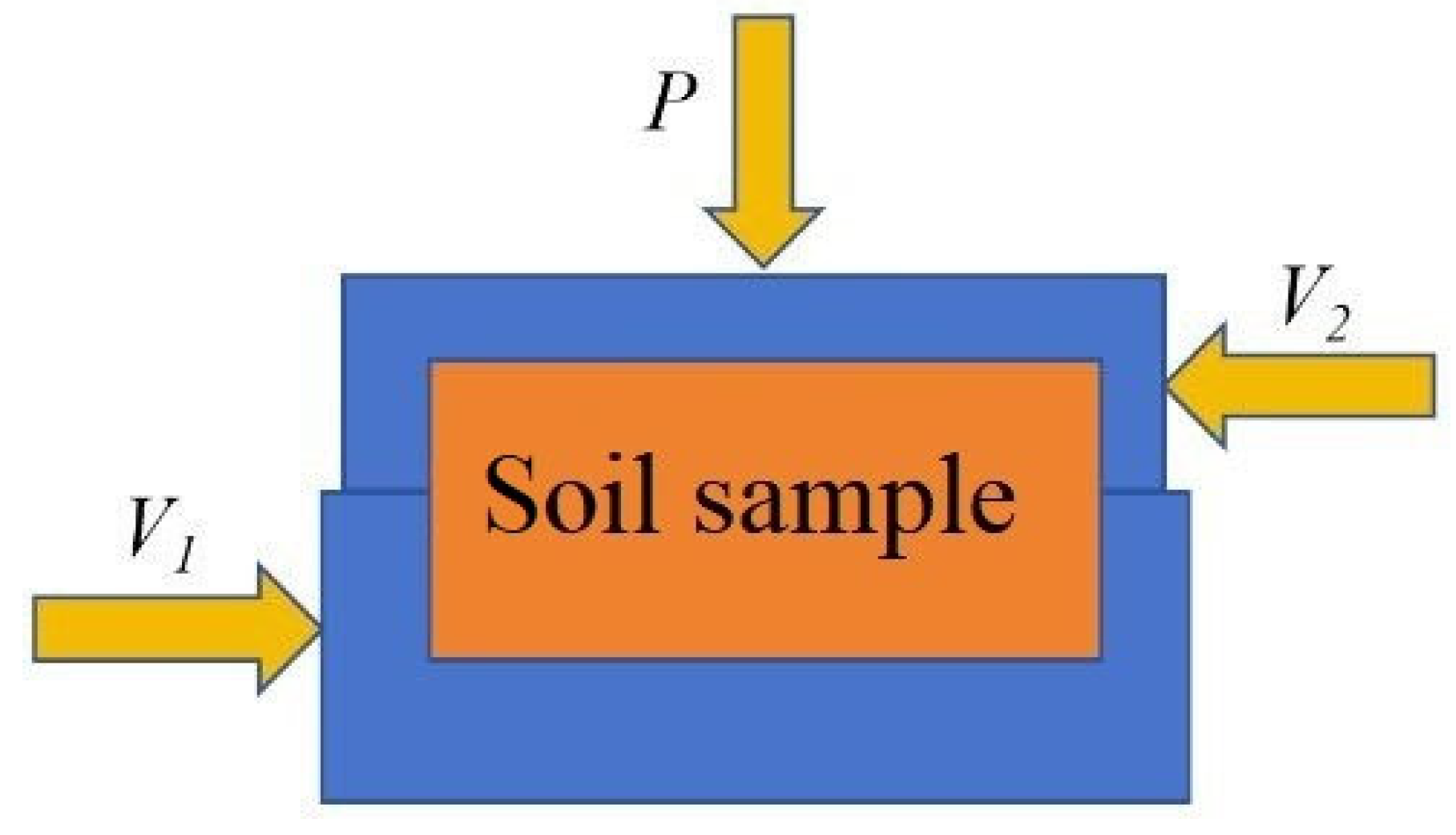
2.3.2. Laboratory Apparatus
2.3.3. Test Process
2.3.4. Analysis of Test Results
2.4. Stubble–Soil Complex Piercing Test
2.4.1. Experimental Method
2.4.2. Laboratory Apparatus
2.4.3. Test Process
2.4.4. Analysis of Test Results
2.5. Simulation Modeling and Experimental Design
2.5.1. Establishment of a Flexible Discrete Element Method Model for Root Stubble
- εa, εb—particle Poisson’s ratio;
- Ea, Eb—elastic modulus of particles, MPa;
- ra, rb—particle radius, mm;
- F—critical pressure, N;
- R—radius of compression surface, mm;
- c—cohesion of stem, MPa;
- φ—internal friction angle, (°).

| Parameter | Numerical Value |
|---|---|
| Poisson’s ratio | 0.32 |
| Density/(kg/m3) | 108 |
| Bonding radius/mm | 1.3 |
| Shear modulus/Pa | 6.4 × 106 |
| Recovery coefficient | References [31,32,33] |
| Static friction coefficient | References [31,32,33] |
| Coefficient of kinetic friction | References [31,32,33] |
| Normal stiffness/(N/m3) | References [31,32,33] |
| Tangential stiffness/(N/m3) | References [31,32,33] |
| Normal critical stress/Pa | References [31,32,33] |
| Tangential critical stress/Pa | References [31,32,33] |
2.5.2. Establishment of the Flexible Discrete Element Model of Soil
2.5.3. Discrete Element Flexible Body Modeling of Residual Film
2.5.4. Discrete Element Flexible Body Modeling of the Root Stubble–Soil-Residual Film Composite
2.5.5. Shear Simulation Test of the Root Stubble–Soil Composite
2.5.6. Piercing Simulation Test of the Root Stubble–Soil Composite
3. Results
3.1. Comparison and Verification of Shear Test Results
3.2. Analysis and Validation of Puncture Test Results
4. Discussion
5. Conclusions
- (1)
- This study conducted relevant research on the soil in the Hexi Corridor and measured related soil indicators. The results showed that the soil type in the Hexi Corridor is extremely sandy, with soil particles larger than 0.05 mm and particles between 0.05 mm and 0.01 mm accounting for 80.69% and 12.67% of the soil mass, respectively. The average soil moisture contents at depths of 50 mm, 100 mm, and 150 mm were 12.93%, 13.55%, and 14.25%, respectively. The soil density was 2490 kg/m3, and the average soil firmness ranged from 2800 to 3000 kPa.
- (2)
- This study conducted shear and puncture tests on the residual film, soil, and root stubble of maize stubble in the Hexi Irrigation District. The results of the shear tests indicated that the average maximum shear forces of the stubble–soil complex at different depths of 30 mm, 50 mm, and 100 mm were 669.54 N, 529.67 N, and 293.53 N, respectively. The puncture test results revealed that the maximum vertical loadings of the steel needle in the stubble–soil complex puncture test at different depths of 50 mm and 100 mm were 36.26 N and 57.76 N, respectively.
- (3)
- This study established a discrete element simulation model of the maize stubble residue film–soil–root complex in the Hexi Irrigation District based on the Bonding-V2 and API rapid filling technology, and simulation tests were conducted. The reliability and accuracy of the simulation model were verified through shear and puncture tests. The results demonstrated that the differences between the simulated maximum shear force and the actual shear tests were 4.8%, 6.4%, and 6.5%. The differences between the simulated puncture tests and the actual puncture tests of two different depth stubble–soil complexes were −6.4% and −12.37%. The small difference between the simulated values and the actual values, along with the consistent particle movement trend with the actual situation, indicates that the discrete element flexible model can represent the field model and can provide a theoretical basis and parameter support for mechanized residual film recycling in China.
Author Contributions
Funding
Institutional Review Board Statement
Data Availability Statement
Acknowledgments
Conflicts of Interest
References
- Gao, H.; Liu, Q.; Yan, C.; Mancl, K.; Gong, D.; He, J.; Mei, X. Macro-and/or microplastics as an emerging threat effect crop growth and soil health. Resour. Conserv. Recycl. 2022, 186, 106549. [Google Scholar] [CrossRef]
- Gao, H.; Yan, C.; Liu, Q.; Ding, W.; Chen, B.; Li, Z. Effects of plastic mulching and plastic residue on agricultural production: A meta-analysis. Sci. Total Environ. 2019, 651, 484–492. [Google Scholar] [CrossRef]
- Hann, S.; Fletcher, E.; Sherrington, C.; Molteno, S.; Elliott, L. Conventional and biodegradable plastics in agriculture. Rep. DG Environ. Eur. Comm. 2021. [Google Scholar]
- Yan, C.R.; Liu, E.K.; Shu, F.; Liu, Q.; Liu, S.; He, W.Q. Review of agricultural plastic mulching and its residual pollution and prevention measures in China. J. Agric. Res. Environ. 2014, 31, 95–102. [Google Scholar]
- Thidar, M.; Gong, D.; Mei, X.; Gao, L.; Li, H.; Hao, W.; Gu, F. Mulching improved soil water, root distribution and yield of maize in the Loess Plateau of Northwest China. Agric. Water Manag. 2020, 241, 106340. [Google Scholar] [CrossRef]
- Zhang, J.; Ren, S.; Xu, W.; Liang, C.; Li, J.; Zhang, H.; Wang, K. Effects of plastic residues and microplastics on soil ecosystems: A global meta-analysis. J. Hazard. Mater. 2022, 435, 129065. [Google Scholar] [CrossRef] [PubMed]
- Kou, J.L.; Wang, J.K.; Wang, L.; Zhao, Y.M. Integrating clamping finger-chain residual film recycling and straw crushing return to cotton field. Trans. Chin. Soc. Agric. Eng. 2023, 39, 14–22. [Google Scholar]
- Guo, J.X.; Liu, Y.C.; Wei, Y.J.; Zhou, J.; Shi, Y. Vibration characteristics analysis of the optimal structure of integrated straw returning and residual film recycling machine. Trans. Chin. Soc. Agric. Eng. 2024, 40, 155–163. [Google Scholar]
- Jin, W.; Zhang, X.J.; Ding, Y.C.; Bai, S.H.; Liu, W.P.; Zhou, X.C. Experiment on Suspension Separation of Residual Film and Impurity Based on EDEM Fluent Coupling. Trans. Chin. Soc. Agric. Mach. 2022, 53, 89–98. [Google Scholar]
- You, Y.; Wang, D.C.; Wang, G.H. 9QP-830 Soil-gashing and Root-cutting Mechanism. Trans. Chin. Soc. Agric. Mach. 2011, 42, 61–67. [Google Scholar]
- Shen, S.L.; Zhang, J.X.; Jiang, Y.X.; Wang, Y.C.; Liu, X.F.; Li, J.M.; Dong, W.H. Research on Tensile Properties of Residual Film in the Tillage Layer Based on Discrete Element Method. Trans. Chin. Soc. Agric. Mach. 2024, 55, 132–141. [Google Scholar]
- Zhang, X.L.; Zhao, Y.Y.; Zhang, X.T.; Shi, X.P.; Shi, X.Y.; Li, F.M. Re-used mulching of plastic film is more profitable and environmentally friendly than new mulching. Soil Tillage Res. 2022, 216, 105256. [Google Scholar] [CrossRef]
- Su, S.L.; Singh, D.N.; Baghini, M.S. A critical review of soil moisture measurement. Measurement 2014, 54, 92–105. [Google Scholar] [CrossRef]
- Li, C.K.; Zhao, D.W.; Lu, X.C. Numerical investigation of terminal residual thickness of the water film and surface flow in the entrainment region in Marangoni drying. Dry. Technol. 2020, 38, 869–878. [Google Scholar] [CrossRef]
- Liu, X.L.; Zhao, W.Y.; Zhang, H.; Wang, G.P.; Sun, W.; Dai, F. Design and experiment of an upper-side-discharge straw-returning and bundle self-unloading integrated corn residual film recycling machine. Int. J. Agric. Biol. Eng. 2023, 16, 61–70. [Google Scholar] [CrossRef]
- Zhang, Y.; Barrouillet, B.; Skadsem, H.J. Experimental investigation of laminar and turbulent displacement of residual oil film. Sci. Rep. 2023, 13, 21120. [Google Scholar] [CrossRef] [PubMed]
- Zhang, Y.J.; Liu, X.F.; Zhang, Q.; Wang, L.G.; Hao, G.L. Influence of Different Herbaceous Roots on Soil Permeability. Res. Soil Water Conserv. 2024, 31, 145–152. [Google Scholar]
- Zheng, L.; Luo, X.W.; Zeng, S.; Wang, Z.M.; Liu, C.B.; Qi, X.Y. Shear Characteristics of Rice Root-Soil Composite. Trans. Chin. Soc. Agric. Mach. 2017, 48, 63–71. [Google Scholar]
- Xu, S.X.; Zhang, Q.W.; Li, W.L.; Chen, W.J.; Chen, Z.Y.; Zhao, C.L. Comparative Analysis of Soil Shear Strength Measured by Strain-Controlled Direct Shear Apparatus and Micro-Vane Shear Apparatus. Res. Soil Water Conserv. 2024, 31, 205–213. [Google Scholar]
- Gao, Z.; Lu, C.Y.; Wei, X.Y.; Li, H.W.; He, J.; Wang, Q.J. Design and Experiment of Co-stirring Combined Corn Strip Straw Cleaning Device. Trans. Chin. Soc. Agric. Mach. 2023, 54, 68–79. [Google Scholar]
- Zhou, H.; Che, H.L.; Geng, D.Y.; Chen, M.Z.; Zhang, Y.P. Discrete Element Modeling and Parameter Calibration of Typical Soil in Maize Field Tillage Layer. Trans. Chin. Soc. Agric. Mach. 2023, 54, 49–60, 113. [Google Scholar]
- Geng, Y.L. Research on the Design of Press Devices and Control of Compaction Pressure for Small and Medium-Sized Corn No-Till Planter. Master’s Thesis, Shandong University of Technology, Zibo, China, 2023. [Google Scholar]
- Li, L.B. Design of the Fertilizing and Subsoiling Cultivator for Conservation Tillage. Master’s Thesis, Shenyang Agricultural University, Shenyang, China, 2023. [Google Scholar]
- Chen, P.P.; Gu, X.B.; Li, Y.N.; Qiao, L.; Li, Y.; Fang, H.; Zhou, C. Effects of residual film on maize root distribution, yield and water use efficiency in Northwest China. Agric. Water Manag. 2022, 260, 107289. [Google Scholar] [CrossRef]
- Shi, Z.; Zhang, X.; Yan, J.; Jiang, Y.; Yao, J. Experiment and Analysis of Film-Soil Separation Motion Characteristics of a Chain Drive Residual Film Recovery Mechanism for the Tillage Layer. Appl. Sci. 2022, 12, 5884. [Google Scholar] [CrossRef]
- Li, J.G.; He, P.R.; Chen, J.; He, Y.F.; Zhong, L.E.; Sun, H. The Effects of Irrigation Water Salinity on Maize Emergence, Yield, Quality and Soil Salt Dynamics. Water-Sav. Irrig. Technol. 2024, 4, 1–10. [Google Scholar]
- Zhang, Z.G.; Xu, H.W.; Xue, H.T.; Ni, C.; Wang, C. Calibration and Experiment of Discrete Element Parameters of Panax notoginseng Stem. Trans. Chin. Soc. Agric. Mach. 2023, 54, 61–70, 91. [Google Scholar]
- Zhao, Z. Cutter-Straw Interaction Mechanism of the Longitudinal Chopping Device for the Corn Harvester and a Study of the Bionic. Ph.D. Thesis, Shenyang Agricultural University, Shenyang, China, 2023. [Google Scholar]
- Chen, J.Z.; Shi, R.J.; Dai, F.; Zhao, W.Y.; Zhao, Y.M.; Xin, S.L. Simulation and Experiment on Interaction Process between Seed Corn and Corn Husking Mechanism. Trans. Chin. Soc. Agric. Mach. 2024, 55, 91–100. [Google Scholar]
- Zhao, S.H.; Liu, H.P.; Hou, L.T.; Zhang, X.; Yuan, Y.W.; Yang, Y.Q. Development of deep fertilizing no-tillage segmented maize sowing opener using discrete element method. Trans. Chin. Soc. Agric. Eng. 2021, 37, 1–10. [Google Scholar]
- Zhao, S.H.; Gao, L.L.; Yuan, Y.W.; Hou, L.T.; Zhang, X.; Yang, Y.Q. Maize straw motion law in subsoiling operation using discrete element method. Trans. Chin. Soc. Agric. Eng. 2021, 37, 53–62. [Google Scholar]
- Zhang, S.; Zhao, H.; Wang, X.; Dong, J.; Zhao, P.; Yang, F.; Huang, Y. Discrete element modeling and shear properties of the maize stubble-soil complex. Comput. Electron. Agric. 2023, 204, 107519. [Google Scholar] [CrossRef]
- Shi, L.; Zhao, W.; Hua, C.; Rao, G.; Guo, J.; Wang, Z. Study on the intercropping mechanism and seeding improvement of the cavity planter with vertical insertion using DEM-MBD coupling method. Agriculture 2022, 12, 1567. [Google Scholar] [CrossRef]
- Zhang, S.; Tekeste, M.Z.; Li, Y.; Gaul, A.; Zhu, D.; Liao, J. Scaled-up rice grain modelling for DEM calibration and the validation of hopper flow. Biosyst. Eng. 2020, 194, 196–212. [Google Scholar] [CrossRef]
- Xie, J.H. Study on Pick-up and Unloading Device for Residual Plastic Film of Bed Planting. Ph.D. Thesis, China Agricultural University, Beijing, China, 2014. [Google Scholar]
- Shi, R.J.; Zhao, W.Y.; Dai, F.; Song, X.F.; Zhao, Y.M.; Wang, F. Simulation of Interaction between Air Flow Field and Soil Seedbed Covering on Whole Plastic Film Mulching on Double Ridges. Trans. Chin. Soc. Agric. Mach. 2022, 53, 40–51. [Google Scholar]
- Wang, X.B. Design and Experimental Study of Biomimetic Deep Loose Shovel Based on Discrete Element Method. Master’s Thesis, Sichuan Agricultural University, Chengdu, China, 2023. [Google Scholar]
- Yang, F.F. Study on the Interaction Mechanism of Straw and Stubble Covered Soil-Winged Subsoiler Based on Discrete Element Method. Master’s Thesis, Northwest A&F University, Yangling, China, 2023. [Google Scholar]
- Hao, Z.H.; Zheng, E.L.; Li, X.; Yao, H.P.; Wang, X.C.; Qian, S.Y.; Li, W.X.; Zhu, M. Performance analysis of the soil-contacting parts for no-tillage planters and optimization of blade structure. Trans. Chin. Soc. Agric. Eng. 2023, 39, 1–13. [Google Scholar]
- Wang, Z.T. Design and Experiment of Soil Mechanical and Physical Properties and Micro-geomorphic Measuring Device. Master’s Thesis, Huazhong Agricultural University, Wuhan, China, 2022. [Google Scholar]
- Liang, R.; Zhang, L.; Jia, R.; Meng, H.; Kan, Z.; Zhang, B.; Li, Y. Study on friction characteristics between cotton stalk-residual film-external contact materials. Ind. Crops Prod. 2024, 209, 118022. [Google Scholar] [CrossRef]
- Yang, S.; Chen, X.; Yan, L.; Jiang, D. Performance of Three Different Spades for Residual Plastic Film Recycling Machine. Appl. Eng. Agric. 2020, 36, 187–195. [Google Scholar] [CrossRef]
- Lin, J.; Lv, Z.Y.; Li, H.Z.; Wang, X.Y.; Wang, D.R. Design and Experiment of Passive Anti-winding Stubble Breaking and Ridge Cleaning Device for No-tillage Planter. Trans. Chin. Soc. Agric. Mach. 2023, 54, 19–27, 37. [Google Scholar]
- Zhang, Z.; Li, J.; Wang, X.; Zhao, Y.; Xue, S.; Su, Z. Parameters optimization and test of an arc-shaped nail-tooth roller-type recovery machine for sowing layer residual film. Agriculture 2022, 12, 660. [Google Scholar] [CrossRef]
- Zhang, H.N. Effects of the Biological Soil Crusts Growth on Soil Detachment Process. Master’s Thesis, Northwest A&F University, Yangling, China, 2022. [Google Scholar]
- Shi, L.R. Research on the Intercropping Mechanism of Maize Hole Seeding with Vertical Insertion in the Dry Northwest. Ph.D. Thesis, Gansu Agricultural University, Lanzhou, China, 2022. [Google Scholar]
- Yuan, X.M.; Li, X.H.; Jiao, H.T.; Zhou, S.L.; Zhang, J.J.; Wu, H.Y. Design and Experiment of Straw Chopping Centralized Full Depth and Returning Machine. Trans. Chin. Soc. Agric. Mach. 2023, 54 (Suppl. S1), 27–35. [Google Scholar]


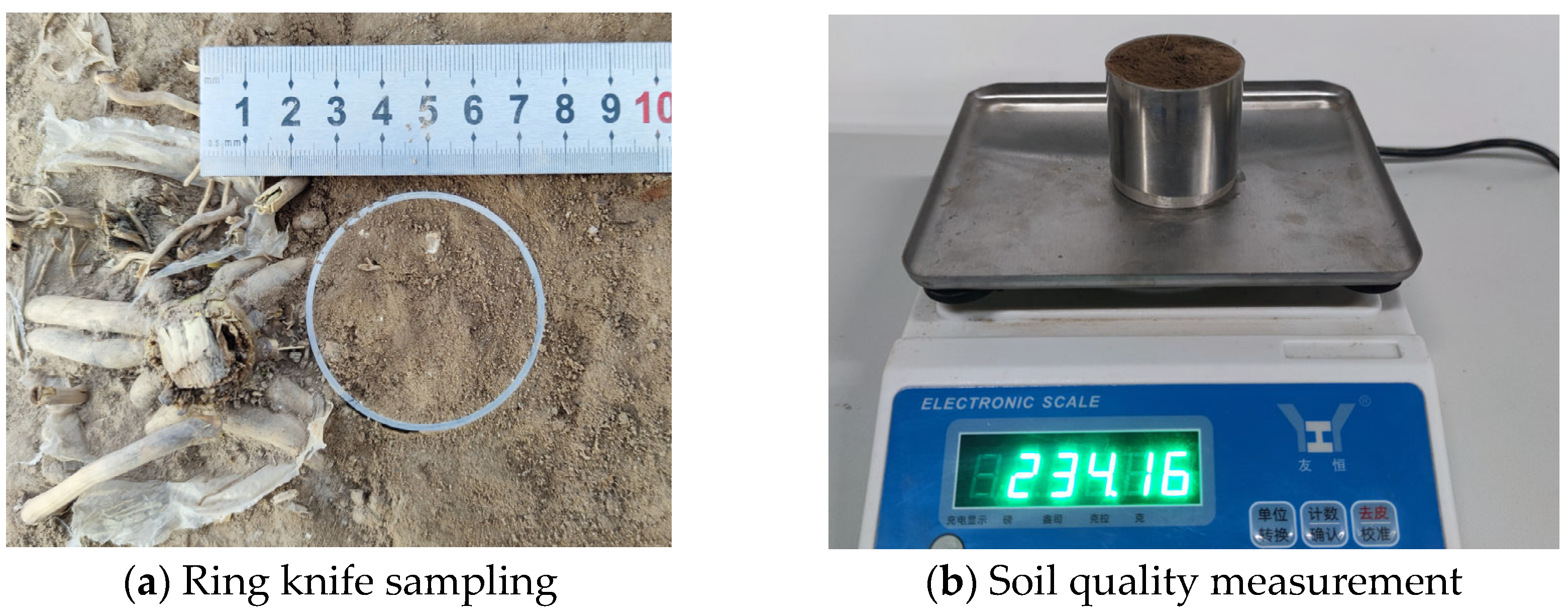







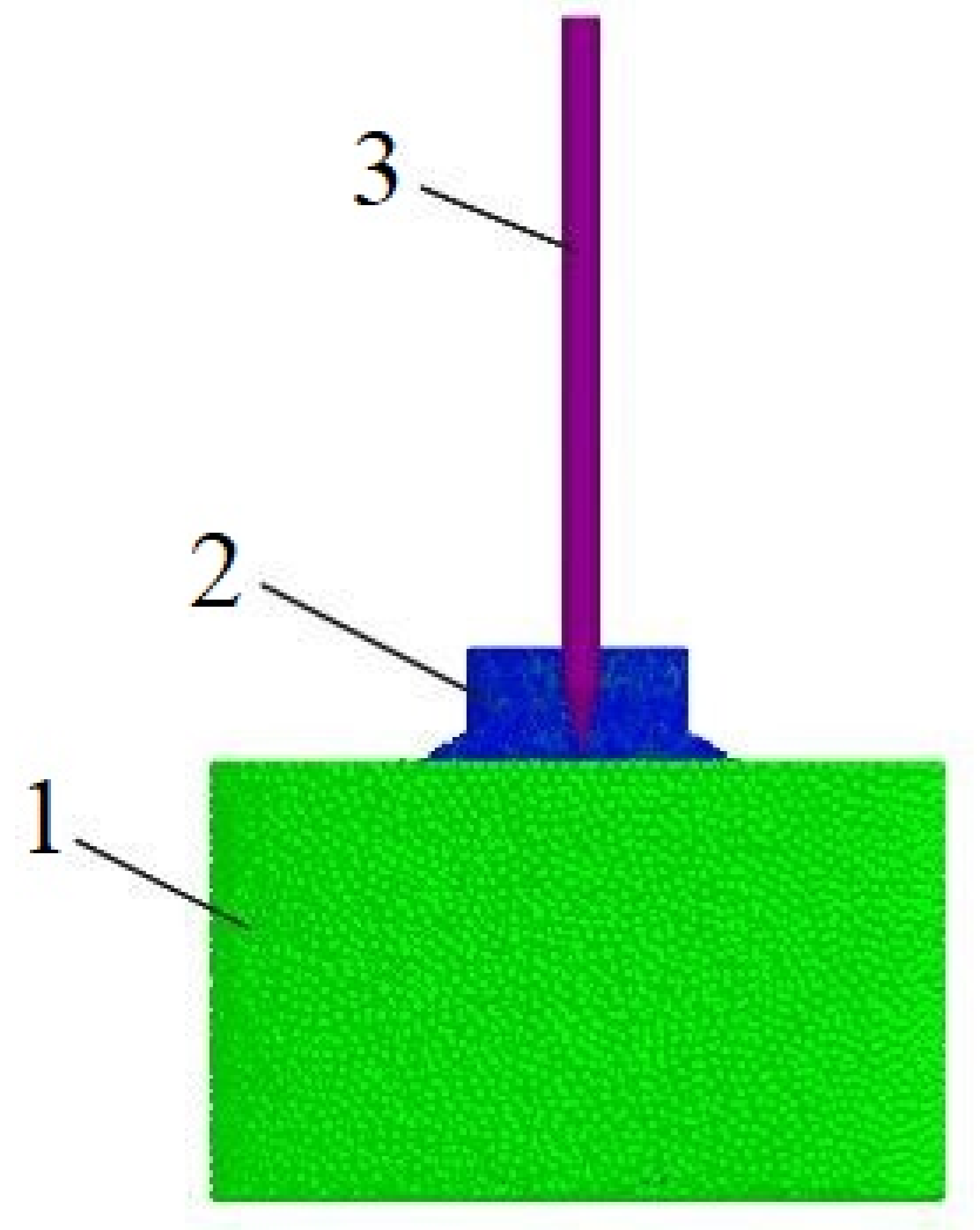
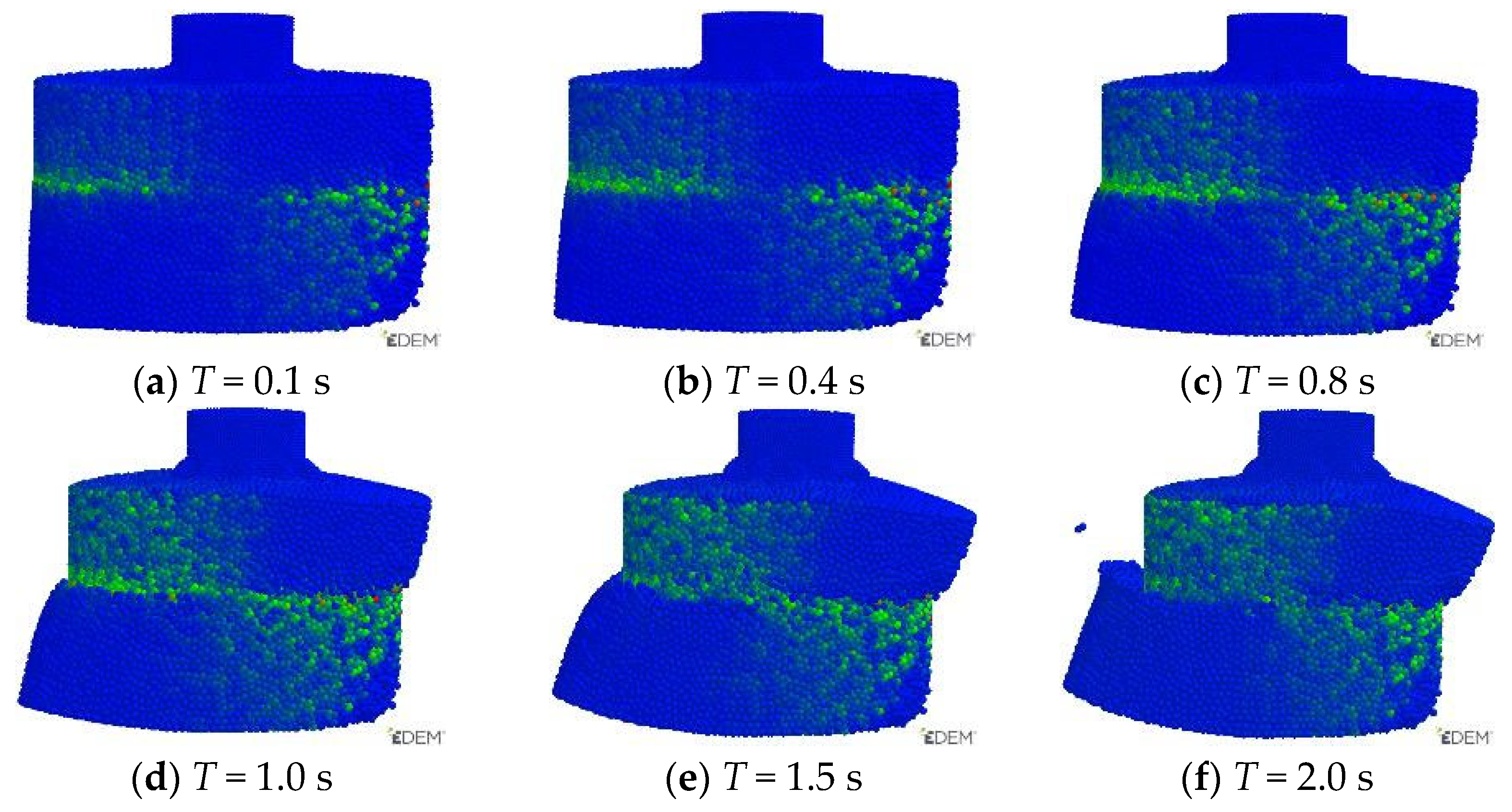


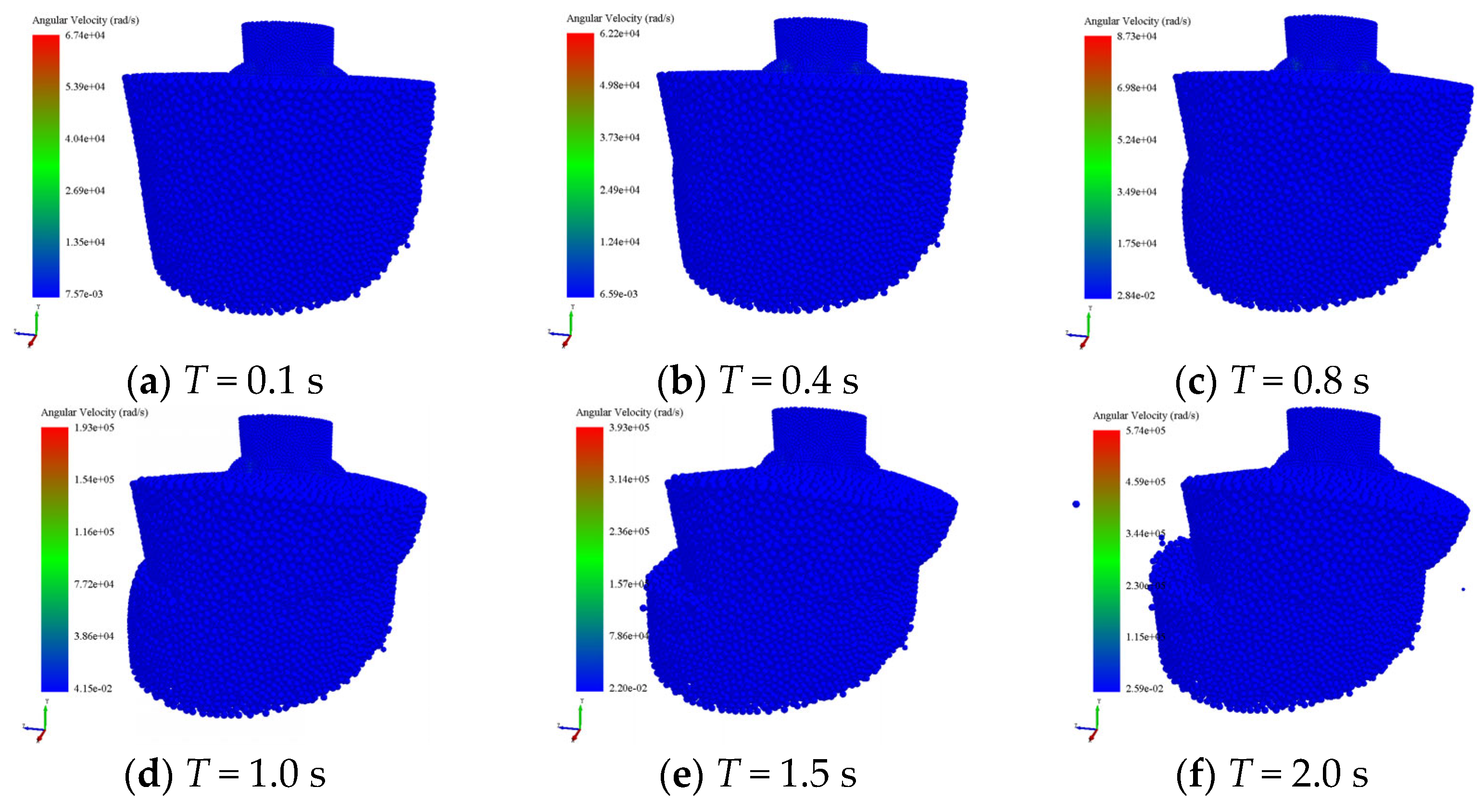

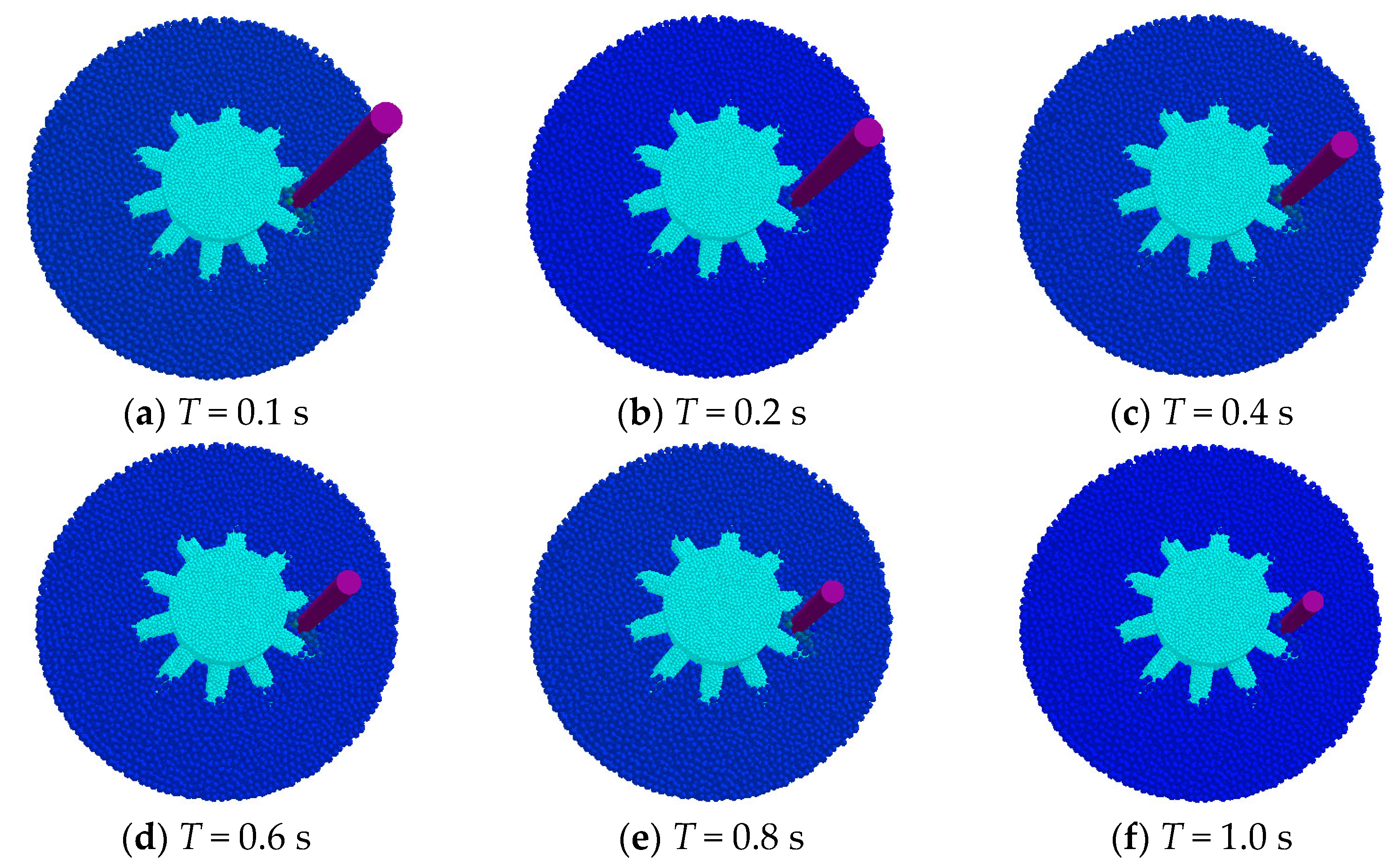
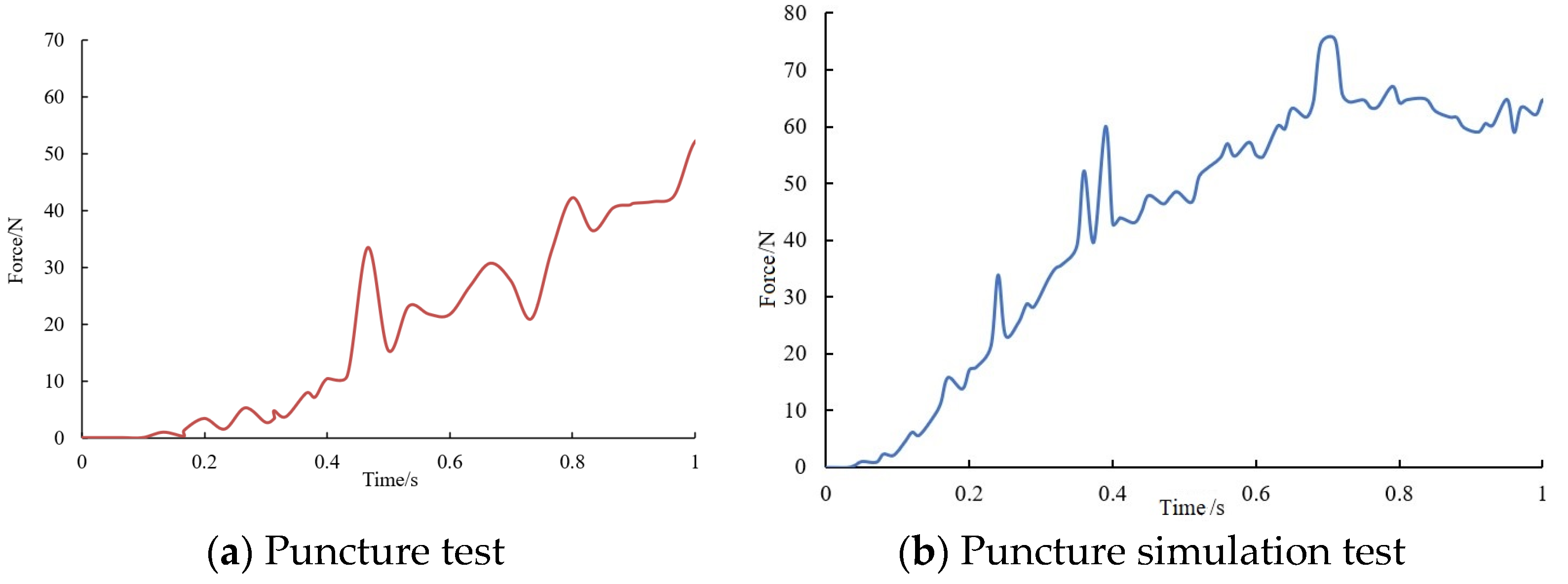
| Sampling Location | Sample Number | Size Composition | ||
|---|---|---|---|---|
| Grains of Sand (1–0.05 mm)/g | Coarse Dust (0.05–0.01 mm)/g | Fine (<0.001 mm)/g | ||
| Soil samples in Hexi Irrigation District | Sample 1 | 168.64 | 27.59 | 0 |
| Sample 2 | 165.38 | 28.6 | 0 | |
| Sample 3 | 167.85 | 26.9 | 0 | |
| Average value | 167.29 | 27.59 | 0 | |
| Percentage | 80.69% | 12.67% | 0 | |
| Soil Types | Center Distance/mm | Sample 1 | Sample 2 | Sample 3 | Average Value |
|---|---|---|---|---|---|
| Sandy soil | 0 | 1.67 | 1.75 | 1.69 | 1.70 |
| 50 | 2.36 | 2.62 | 2.49 | 2.49 | |
| 100 | 2.46 | 2.58 | 2.36 | 2.47 | |
| 150 | 2.42 | 2.58 | 2.53 | 2.51 |
| Serial Number | Depth/mm | Maximum Shear Force/N | Average Value/N |
|---|---|---|---|
| 1 | 30 | 668.9 | 665.16 |
| 2 | 30 | 652.5 | |
| 3 | 30 | 678.3 | |
| 4 | 30 | 628.6 | |
| 5 | 30 | 697.5 | |
| 6 | 50 | 516.7 | 523.94 |
| 7 | 50 | 502.3 | |
| 8 | 50 | 499.6 | |
| 9 | 50 | 559.7 | |
| 10 | 50 | 541.4 | |
| 11 | 100 | 380.6 | 376.76 |
| 12 | 100 | 359.9 | |
| 13 | 100 | 395.6 | |
| 14 | 100 | 345.1 | |
| 15 | 100 | 402.6 |
| Serial Number | Depth/mm | Maximum Loading Force/N | Average Value/N |
|---|---|---|---|
| 1 | 50 | 36.69 | 36.26 |
| 2 | 50 | 32.36 | |
| 3 | 50 | 35.67 | |
| 4 | 50 | 32.54 | |
| 5 | 50 | 44.05 | |
| 6 | 100 | 58.21 | 57.76 |
| 7 | 100 | 59.36 | |
| 8 | 100 | 57.39 | |
| 9 | 100 | 59.79 | |
| 10 | 100 | 54.04 |
| Parameter | Numerical Value |
|---|---|
| Poisson’s ratio | 0.3 |
| Density/(kg/m3) | 2490 |
| Shear modulus/Pa | 5 × 107 |
| Bonding radius/mm | 2.8 |
| Recovery coefficient | References [32,33,34,35] |
| Static friction coefficient | References [32,33,34,35] |
| Coefficient of kinetic friction | References [32,33,34,35] |
| Normal stiffness/(N/m3) | References [32,33,34,35] |
| Tangential stiffness/(N/m3) | References [32,33,34,35] |
| Normal critical stress/Pa | References [32,33,34,35] |
| Tangential critical stress/Pa | References [32,33,34,35] |
| Soil–stubble recovery coefficient | References [32,33,34,35] |
| Soil–stubble static friction coefficient | References [32,33,34,35] |
| Soil–stubble dynamic friction coefficient | References [32,33,34,35] |
| Parameter | Numerical Value |
|---|---|
| Poisson’s ratio | 0.5 |
| Density/(kg/m3) | 950 |
| Shear modulus/Pa | 6.65 × 107 |
| Recovery coefficient | References [36,37] |
| Static friction coefficient | References [36,37] |
| Coefficient of kinetic friction | References [36,37] |
| Normal stiffness/(N/m3) | 3 × 107 |
| Tangential stiffness/(N/m3) | 3 × 107 |
| Normal critical stress/Pa | 6 × 106 |
| Tangential critical stress/Pa | 6 × 106 |
| Bonding radius/mm | 1.95 |
| Residual film–stubble recovery coefficient | 0.3 |
| Residual film–stubble static friction coefficient | 0.2 |
| Residual film–stubble dynamic friction coefficient | 0.12 |
| Residual film–soil recovery coefficient | References [36,37] |
| Residual film–soil static friction coefficient | References [36,37] |
| Residual film–soil dynamic friction coefficient | References [36,37] |
Disclaimer/Publisher’s Note: The statements, opinions and data contained in all publications are solely those of the individual author(s) and contributor(s) and not of MDPI and/or the editor(s). MDPI and/or the editor(s) disclaim responsibility for any injury to people or property resulting from any ideas, methods, instructions or products referred to in the content. |
© 2024 by the authors. Licensee MDPI, Basel, Switzerland. This article is an open access article distributed under the terms and conditions of the Creative Commons Attribution (CC BY) license (https://creativecommons.org/licenses/by/4.0/).
Share and Cite
Liu, X.; Shi, R.; Zhao, W.; Sun, W.; Li, P.; Li, H.; Zhang, H.; Wang, J.; Wang, G.; Dai, F. Study on the Characteristics of Residual Film–Soil–Root Stubble Complex in Maize Stubble Fields of the Hexi Corridor and Establishment of a Discrete Element Model. Agriculture 2024, 14, 1542. https://doi.org/10.3390/agriculture14091542
Liu X, Shi R, Zhao W, Sun W, Li P, Li H, Zhang H, Wang J, Wang G, Dai F. Study on the Characteristics of Residual Film–Soil–Root Stubble Complex in Maize Stubble Fields of the Hexi Corridor and Establishment of a Discrete Element Model. Agriculture. 2024; 14(9):1542. https://doi.org/10.3390/agriculture14091542
Chicago/Turabian StyleLiu, Xiaolong, Ruijie Shi, Wuyun Zhao, Wei Sun, Peiwen Li, Hui Li, Hua Zhang, Jiuxin Wang, Guanping Wang, and Fei Dai. 2024. "Study on the Characteristics of Residual Film–Soil–Root Stubble Complex in Maize Stubble Fields of the Hexi Corridor and Establishment of a Discrete Element Model" Agriculture 14, no. 9: 1542. https://doi.org/10.3390/agriculture14091542
APA StyleLiu, X., Shi, R., Zhao, W., Sun, W., Li, P., Li, H., Zhang, H., Wang, J., Wang, G., & Dai, F. (2024). Study on the Characteristics of Residual Film–Soil–Root Stubble Complex in Maize Stubble Fields of the Hexi Corridor and Establishment of a Discrete Element Model. Agriculture, 14(9), 1542. https://doi.org/10.3390/agriculture14091542








